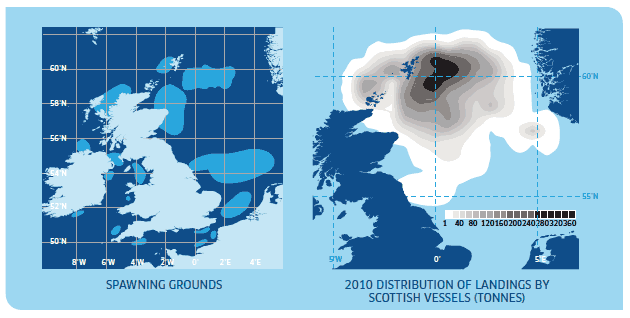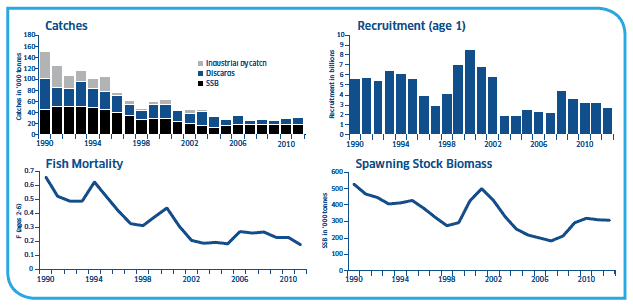Fish and Shellfish Stocks: 2013
Information on the state of fish and shellfish stocks of commercial importance to the Scottish fleet, inclduing Total Allowable Catches (TACs) for each stock.
Whiting Stocks - North Sea (IV & VIId)
Whiting ( Merlangius merlangus) is caught all year round, mainly in mixed demersal fisheries with some bycatch taken in the industrial fisheries. It's found throughout the North Sea, but is known to occur exclusively in some localised areas. Discarding of this species is still quite high.
2013 position : UK share 11,402 tonnes
Last Year : 10,539 tonnes
Landed into
Scotland in 2011 : 6,600 tonnes
Value for 2011 : £9.61 million
Biology
Whiting is one of the most numerous and widespread species found in the North Sea. High numbers of immature fish occur off the Scottish coast, in the German Bight and along the coast of the Netherlands. Tagging experiments, and the use of a number of fish parasites as markers, show that the whiting found to the north and south of the Dogger Bank form two virtually separate populations. It is also likely that the whiting in the northern North Sea may contain populations including 'inshore' and 'offshore' groups.
At four years old, a single female fish of reasonable size produces more than 400,000 eggs. By two years old, however, most whiting are mature and able to spawn. The spawning season lasts from late January until June. The spawning season of an individual female lasts at least ten weeks, during which time she releases many batches of eggs.
Like many other fish, whiting spend their first few months of life in the upper water layers before moving to the seabed. They grow very quickly for the first year, after which the growth rate becomes much slower. There are large differences between the growth rates of individual fish and a 30 cm fish can be as young as one year or as old as six. The whiting in the northern North Sea usually grow faster than their more southern counterparts.
Adult whiting feed mainly on juvenile fish and crustaceans (shrimps and crabs). The exact composition of the diet depends on the size of the fish, the area and the time of the year. In the North Sea, whiting is one of the main predators of other commercially important species of fish. Norway pout, sandeel, haddock, cod and even whiting themselves are frequently eaten. It has been estimated that each year the North Sea whiting population consumes several hundred thousand tonnes of these species.

ICES Advice on Management
Information Source: ICES advice 2012 ( http://www.ices.dk/sites/pub/Publication%20Reports/Advice/2012/2012/whg-47d.pdf). Quoted text in italics.

MSY and precautionary approach reference points
| Type | Value | |
|---|---|---|
| Management Plan | SSB MP | Undefined |
| F MP | 0.3 | |
| MSY Approach | MSY B trigger | Undefined |
| F MSY | Undefined | |
| Precautionary Approach | B lim | Undefined |
| B pa | Undefined | |
| F lim | Undefined | |
| F pa | Undefined |
State of stock and advice
- Fishing mortality in 2011 was estimated to be 0.17: this means that approximately 16%, by number, of all fish aged between 2 and 6 years were caught.
- Spawning stock biomass in 2012 was estimated to be approximately 306,814 tonnes.
- Fishing mortality and biomass cannot be determined in relation to the precautionary approach, as reference points have not been defined for this stock.
- The ICES advice is based on precautionary considerations, recommending a human consumption TAC in 2013 of 26,000 tonnes for Subarea IV (North Sea) and Division VIId (Eastern Channel). Management for Division VIId should be separated from the rest of Subarea VII.
In 2011 ICES considered an F target of 0.3 (with a 15% TAC constraint) to be consistent with long-term stability even when recruitment is poor for several consecutive years. Based on a considerable revision in the level of fishing mortality in 2012 (caused by new estimates in natural mortality), the target F is no longer considered applicable and the management target needs re-evaluation.
There are no reference points to give advice on TACs for the MSY or precautionary approaches.
The use of new natural mortality estimates has substantially increased estimates of recruitment and SSB, and decreased estimates of fishing mortality by approximately 25%, while the trends have remained similar.
Last year, the advice was based on the EU-Norway management plan. This year's advice is based on precautionary considerations.
Management outcomes for 2013
At the December 2012 meeting in Brussels, the Council of Ministers decided that the EU Total Allowable Catch for North Sea (IV and IIa) whiting should be 18,932 tonnes. The UK quota for 2013 was set at 11,402 tonnes.
This quota decision reached was in line with the scientific advice based on an interim EU Norway management plan. Hague preference was invoked which adjusted the final outcome.
Contact
There is a problem
Thanks for your feedback